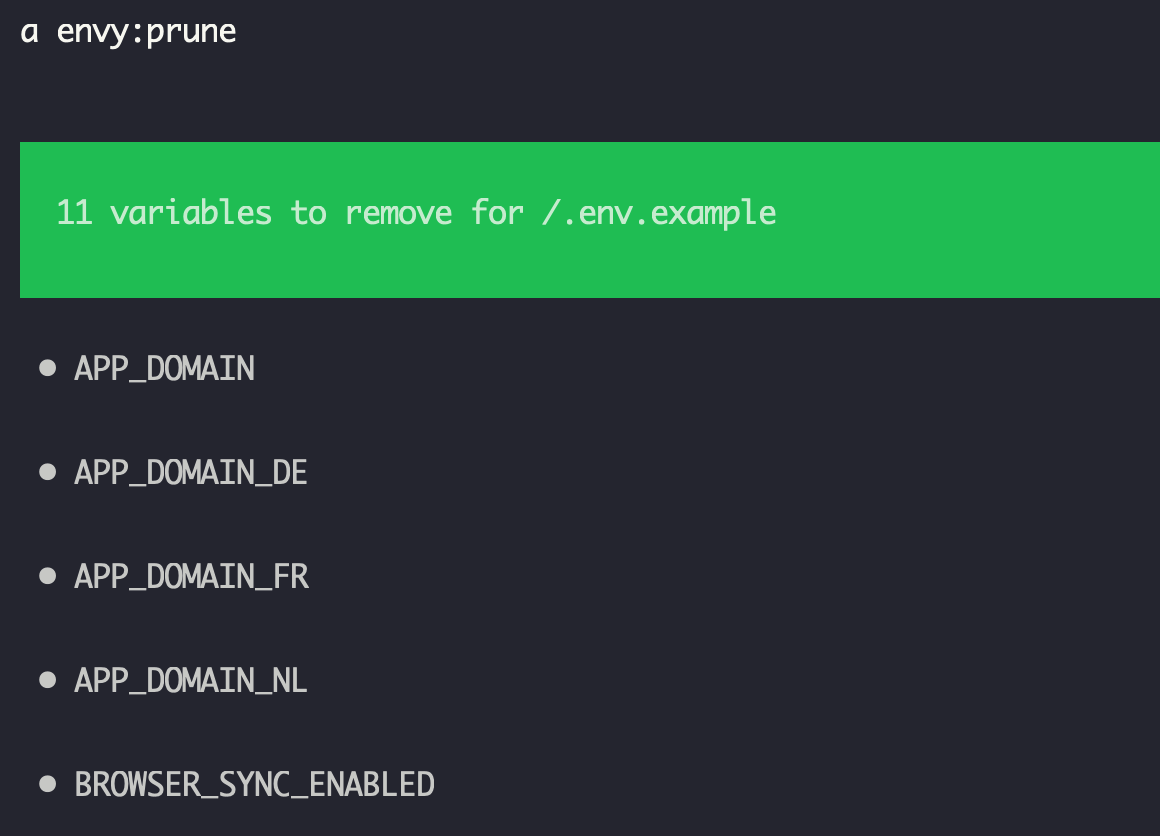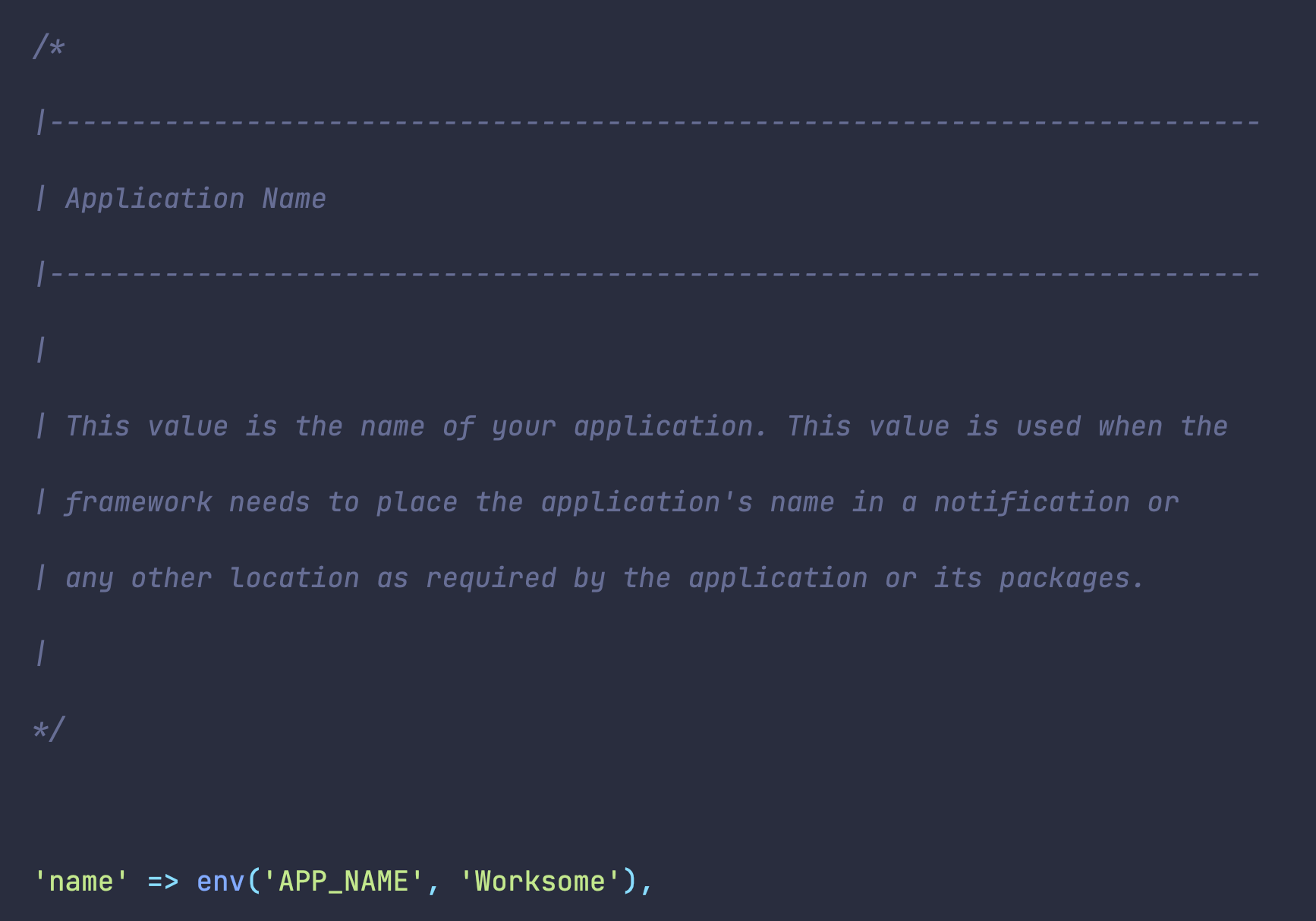worksome / envy
Automatically keep your .env files in sync.
Fund package maintenance!
worksome
Installs: 1 213 235
Dependents: 0
Suggesters: 0
Security: 0
Stars: 674
Watchers: 18
Forks: 30
Open Issues: 2
Requires
- php: ^8.2
- illuminate/contracts: ^10.0 || ^11.0
- nikic/php-parser: ^4.19.1 || ^5.0.2
- nunomaduro/termwind: ^1.15 || ^2.0
- spatie/laravel-package-tools: ^1.16
- thecodingmachine/safe: ^2.4
Requires (Dev)
- larastan/larastan: ^2.6
- nunomaduro/collision: ^7.0 || ^8.1
- orchestra/testbench: ^8.0 || ^9.0
- pestphp/pest: ^2.33
- pestphp/pest-plugin-laravel: ^2.2
- worksome/coding-style: ^2.8
README
Automate keeping your environment files in sync.
How many times have you onboarded a new dev onto your team, only to have to spend ages debugging with them because your project's .env.example file is wildly outdated? Too many to count, if you're anything like us. Wouldn't it be nice if there were a way to ensure your environment files stay up to date? That's why we created Envy!
With a simple Artisan command, you can sync your environment files with your project config to keep everything fresh.
Installation
You can install the package via composer:
composer require worksome/envy --dev
We recommend publishing our config file, which allows you to fine-tune Envy to your project's requirements. You can do that using our install command:
php artisan envy:install
That's it! You're now ready to start using Envy.
Usage
Envy provides two commands: envy:sync and envy:prune. Let's break down how to use each of them.
php artisan envy:sync
This command combs through your project's config files for calls to Laravel's env function. After finding them all, it will compare them against your configured environment files (by default just your .env.example) for missing entries. If there are missing entries, you will be given the choice to either:
- Add the missing keys to your environment file
- Add the missing keys to Envy's exclusion list
To learn more about configuring environment files, config files and exclusions, see the Configuration documentation.
The envy:sync command provides several options you might find helpful.
--path
If you'd like to run the sync command against a certain environment file, rather than your configured environment files, you may pass the path to the specified environment file using this option.
--dry
The --dry option will prevent the command from actually performing any updates. This is useful if you want to run Envy as part of a CI check without actually making updates. If missing entries were found, the command will fail, which would in turn fail the check in CI.
--force
If you want to automatically make changes to your configured environment files without being asked to confirm, you may pass the --force option. This is useful for CI bots, where you want to automate changes to your .env.example file, as no user input will be requested.
php artisan envy:prune
This command will search your project's configured environment files (by default just your .env.example) for entries that could not be found in any of the configured config files. If there are additional entries, you will be given the choice to either:
- Remove the additional entries from your environment file
- Add the missing keys to Envy's inclusion list
To learn more about configuring environment files, config files and inclusions, see the Configuration documentation.
The envy:prune command provides several options you might find helpful.
--path
If you'd like to run the prune command against a certain environment file, rather than your configured environment files, you may pass the path to the specified environment file using this option.
--dry
The --dry option will prevent the command from actually pruning any environment variables. This is useful if you want to run Envy as part of a CI check without actually making updates. If additional entries were found, the command will fail, which would in turn fail the check in CI.
--force
If you want to automatically make changes to your configured environment files without being asked to confirm, you may pass the --force option. This is useful for CI bots, where you want to automate changes to your .env.example file, as no user input will be requested.
Configuration
You can customise Envy to suit your project's requirements using our envy.php config file. Here is a breakdown of the available options.
environment_files
Out of the box, Envy will only make changes to your .env.example file. If you want to add additional .env files, such as .env.testing or .env.dusk, you can append them to this array.
⚠️ We do not recommend adding your
.envfile to this array as it could cause unwanted side effects, particularly in CI.
config_files
By default, Envy will recursively scan all files in your project's config directory. For most projects, this will suffice. If your project makes env calls outside of config files (which is an anti-pattern), you should add the relevant files or directories to this array.
This is also useful if you make use of a package for which you have not published its config file. You may instead add an entry to this array that points to the base config file in the vendor directory.
Note that if you reference a directory instead of a file, it will include all files in that directory recursively.
display_comments
Some config keys, such as the one pictured above, may include comments. If you set display_comments to true, we will convert the config comment to an environment comment and place it above the relevant environment variable when inserting it into your configured environment files. This can be helpful in certain projects for remembering the purpose of various environment variables.
display_location_hints
When combing your config files, we make a note of the file and line where you called env. If you set display_location_hints to true, we will create a comment with this location information and place it above the relevant environment variable when inserting it into your configured environment files. This can be helpful in certain projects for locating the usage of various environment variables.
display_default_values
When combing your config files, we make a note of any default parameter set in the env call. For example, given a call for env('APP_NAME', 'Laravel'), the default would be 'Laravel'. If display_default_values is set to true, we will insert the default value as the value for the relevant environment variable when updating your configured environment files.
For obvious reasons, we will only insert scalar (primitive) types when copying default values.
⚠️ If you have
exclude_calls_with_defaultsset totrue(which is the default), this option will have no effect because calls with defaults will be ignored.
exclude_calls_with_defaults
If you copy over every single call to env, your environment files will quickly become difficult to read. To help alleviate this, we provide the option to ignore calls to env that have default values provided. By default this is enabled, but setting this to false will let Envy sync environment variables that have defaults too.
exclusions
This array is a collection of environment keys that should never be synced to your environment files. By default, we include all Laravel environment variables that aren't included in the default .env file created when you first create a new Laravel project. Removing values from this array will cause them to be picked up again whilst syncing. Of course, if you have custom variables or variables provided by packages that you want to ignore, you may add them here.
If you select the Add to exclusions option when running php artisan envy:sync, this array will be updated with the environment variables listed by that command.
💡 You may still manually insert keys from your exclusions into your
.envfile. We won't remove them.
inclusions
This array is a collection of environment keys that we should never prune from your configured environment files, even if we cannot find reference to those variables in your configured config files. This can be useful for JS variables used by Laravel Mix, for example.
If you select the Add to inclusions option when running php artisan envy:prune, this array will be updated with the environment variables listed by that command.
Advanced
Once you're familiar with the basics of Envy, you may find these advanced features useful.
Filters
Sometimes, you'll want a more powerful way to represent items in the exclusions and inclusions lists than basic strings. For example, imagine you want to add all environment variables beginning with STRIPE_ to the
exclusions list. Rather than manually inserting them all individually, you can use the Worksome\Envy\Support\Filters\Filter class.
/** * Any environment variables that are added to exclusions will never be inserted * into .env files. Our defaults are based on the base Laravel config files. * Feel free to add or remove variables as required by your project needs. */ 'exclusions' => [ Filter::wildcard('STRIPE_*'), ],
Now, any environment variable starting with STRIPE_ will automatically be excluded when syncing to your configured environment files. We also offer Filter::regex, which is an even more powerful
filter that allows you to match environment variables against regular expression you provide. In fact, the exclusions and inclusions lists will accept a string or any class which implements
the Worksome\Envy\Contracts\Filter contract, so you can even implement your own filters if that's your style.
Testing
We pride ourselves on a thorough test suite and strict static analysis. You can run all of our checks via a composer script:
composer test
To make it incredibly easy to contribute, we also provide a docker-compose file that will spin up a container with all the necessary dependencies installed. Assuming you have docker installed, just run:
docker-compose run --rm composer install # Only needed the first time docker-compose run --rm composer test # Run tests and static analysis
Support for XDebug is baked into the Docker image, you just need to configure the XDEBUG_MODE environment variable:
docker-compose run --rm -e XDEBUG_MODE=debug php
Changelog
Please see CHANGELOG for more information on what has changed recently.
Credits
License
The MIT License (MIT). Please see License File for more information.



